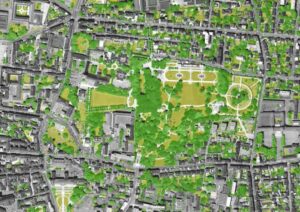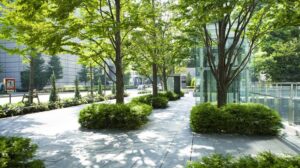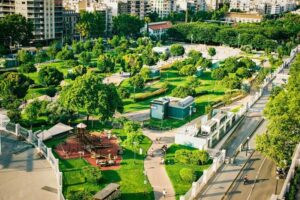Back to: Botany 500 Level
How far, my Afrilearn superstar?
I hope you dey okay today, because we go talk about one very important topic for our cities—Urban Vegetation Planning. E go show you how we fit improve our urban areas, make them more beautiful, and still protect the environment. We all know say cities like Lagos, Abuja, and Port Harcourt dey grow fast, and the question wey dey come up now be: How we go balance development with the need for nature?
Urban vegetation planning
Wetin Be Urban Vegetation Planning?
Urban vegetation planning na the process of designing, planting, and managing trees, plants, and other green spaces within cities. This involves selecting the right types of plants, trees, and shrubs to put in parks, streets, and other urban areas to improve the environment. The goal is to make cities more livable, healthier, and more beautiful while helping nature and human life thrive together.

You fit think of urban vegetation planning like planting “green solutions” to city problems, so that we no just build houses and roads, but we also build an environment where people and nature go live in peace.
Why Urban Vegetation Planning Dey Important?
- Improve Air Quality:
Plants, especially trees, absorb carbon dioxide and release oxygen. This helps improve the quality of the air we breathe. In Nigerian cities, where air pollution from cars and industries dey high, trees can help reduce the amount of harmful gases. - Reduce Heat:
Cities like Lagos, Aba, and Kano can be very hot, with temperatures rising because of all the buildings, concrete, and cars. Plants and trees help cool down the environment by providing shade and releasing moisture into the air, which helps lower temperatures. - Provide Green Spaces for Relaxation:
Green spaces like parks and gardens provide areas where people can relax, exercise, or have fun with their families. These areas are crucial for the mental and physical well-being of city dwellers. - Prevent Soil Erosion and Flooding:
When it rains heavily in Nigerian cities, floodwater can destroy property and cause harm. Trees and plants help absorb water and reduce soil erosion. They also improve the drainage of rainwater, preventing floods in urban areas. - Support Biodiversity:
Urban vegetation provides homes for birds, insects, and other animals that might otherwise struggle to survive in cities. By planting the right plants, cities can support wildlife and help restore ecosystems.
Components of Urban Vegetation Planning
Urban vegetation planning is not just about planting a few trees here and there; it’s about creating a thoughtful and well-designed plan. Here are some important components:
- Street Trees:
Trees planted along streets help to cool the environment and provide shade. For example, you can find trees like the Neem tree, which is popular in many Nigerian cities, lining busy streets. These trees help reduce air pollution and offer a place for people to rest. - Parks and Gardens:
Parks are important places where people can relax, play, or do physical activities. For example, Tafawa Balewa Square in Lagos or the Millennium Park in Abuja provides green spaces for residents to enjoy fresh air, rest, and exercise. - Green Roofs and Walls:
For places where there is little space for ground planting, buildings can have gardens on the roof or walls. These green roofs and walls help cool the building and absorb rainwater. - Community Gardens:
Community gardens allow people in urban areas to grow their own food, plants, and flowers. This not only helps improve food security, but also brings people together and strengthens community bonds.

Types of Plants Used in Urban Vegetation
Not all plants are suitable for urban environments, so urban planners carefully select the best plants for different areas. Some of the most common types of plants used in urban vegetation planning are:
- Shade Trees:
These are trees with large canopies that provide shade and cool the environment. Examples include Mango, Cashew, and Mohogany trees. - Flowering Plants:
Flowering plants like Bougainvillea, Sunflowers, and Hibiscus can add beauty and colour to public spaces. - Bushes and Shrubs:
These are smaller plants that help with landscaping, providing additional greenery. They can also help reduce the impact of wind and noise in busy areas. - Grass and Ground Covers:
Grass lawns and low-lying plants can be used to cover large areas in parks, streets, and other open spaces.
Challenges in Urban Vegetation Planning in Nigeria
- Limited Space:
Cities are expanding quickly, and land is becoming more expensive. There may be limited space for planting trees and creating green spaces, especially in crowded areas like Lagos Island. - Pollution and Climate Change:
The high levels of air pollution and rising temperatures in Nigerian cities make it harder for some plants to survive. Trees and plants may struggle to grow well if they are exposed to too much pollution or extreme heat. - Maintenance Costs:
Urban vegetation requires regular maintenance, like watering, pruning, and protecting the plants from pests. This can be expensive, especially for local governments that may not have enough resources. - Lack of Awareness:
Some people may not see the value of planting trees and creating green spaces in cities. There is a need for more public education on the benefits of urban vegetation.
Examples of Urban Vegetation Planning in Nigerian Cities
- Abuja Green City Plan:
Abuja, the capital city of Nigeria, has a green city plan to create more parks and green spaces. For example, the Millennium Park is a beautiful urban park where residents can enjoy the outdoors, and the city has plans to plant more trees along major roads. - Lagos Greening Project:
Lagos State government has started a project to plant more trees along major roads and highways. They also plan to create more public parks and green spaces to improve air quality and provide recreational areas for the public. - Port Harcourt Green Spaces:
Port Harcourt is also working on creating more green areas within the city. The Rivers State Government has partnered with environmental NGOs to restore parks, plant trees, and promote the creation of community gardens.

Summary:
- Urban vegetation planning involves designing and planting trees and plants in cities to improve air quality, reduce heat, prevent flooding, and provide recreational spaces.
- Components of urban vegetation include street trees, parks, green roofs, and community gardens.
- It helps in supporting biodiversity, enhancing the beauty of cities, and improving people’s well-being.
- Challenges to urban vegetation planning include limited space, pollution, climate change, and maintenance costs.
Evaluation:
- What are two benefits of urban vegetation?
- Name one challenge to urban vegetation planning in Nigeria.
- How can urban vegetation help reduce heat in cities?
You dey do well, Afrilearn genius!
With your new knowledge on urban vegetation planning, you fit help make Nigerian cities greener, cooler, and healthier. Keep up the great work, and I’m excited for our next lesson together! Let’s keep pushing for a better and greener world!
